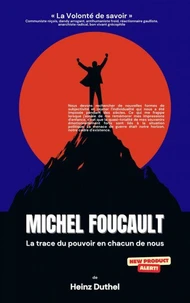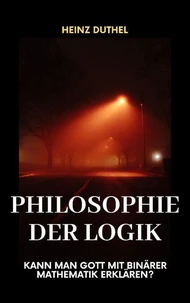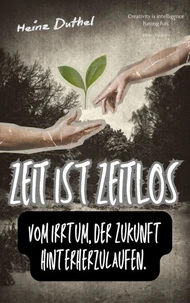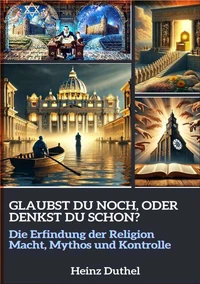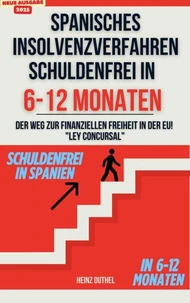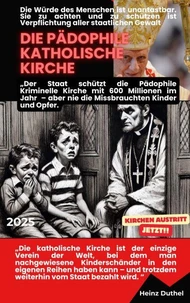Exciting femme fatale. Bonds of irresistible desire
Par :Formats :
Disponible dans votre compte client Decitre ou Furet du Nord dès validation de votre commande. Le format ePub est :
- Compatible avec une lecture sur My Vivlio (smartphone, tablette, ordinateur)
- Compatible avec une lecture sur liseuses Vivlio
- Pour les liseuses autres que Vivlio, vous devez utiliser le logiciel Adobe Digital Edition. Non compatible avec la lecture sur les liseuses Kindle, Remarkable et Sony
 , qui est-ce ?
, qui est-ce ?Notre partenaire de plateforme de lecture numérique où vous retrouverez l'ensemble de vos ebooks gratuitement
Pour en savoir plus sur nos ebooks, consultez notre aide en ligne ici
- Nombre de pages337
- FormatePub
- ISBN978-3-7427-4075-5
- EAN9783742740755
- Date de parution25/04/2018
- Protection num.Digital Watermarking
- Taille322 Ko
- Infos supplémentairesepub
- Éditeurneobooks
Résumé
I feel like a man who goes to the trash can and looks for things that other peoples do not want and gave thrown away.
WOMAN? Very simple, say the fanciers of simple formulas: she is a womb, an ovary; she is a female - this word is sufficient to define her.
"At least two thirds of our miseries spring from human stupidity, human malice and those great motivators and justifiers of malice and stupidity, idealism, dogmatism and proselytizing zeal on behalf of religious or political idols."
In the Middle Ages, the idea of the dangers of female sexuality, typified by Eve, was commonly expressed in medieval romances as a wicked, seductive enchantress, the prime example being Morgan le Fay.
The femme fatale flourished in the Romantic period in the works of John Keats, notably "La Belle Dame sans Merci" and "Lamia".
Along with them, there rose the gothic novel, The Monk featuring Matilda, a very potent femme fatale. This led to her appearing in the work of Edgar Allan Poe, and as the vampiress, notably in Carmilla and Brides of Dracula. The Monk was greatly admired by the Marquis de Sade, for whom the femme fatale symbolised not evil, but all the best qualities of Women, with his novel Juliette being perhaps the earliest wherein the femme fatale triumphs.
Pre-Raphaelite painters frequently used the classic personifications of the femme fatale as a subject. No longer was she merely the dancing-girl who extorts a cry of lust and concupiscence from an old man by the lascivious contortions of her body; who breaks the will, masters the mind of a King by the spectacle of her quivering bosoms, heaving belly and tossing thighs; she was now revealed in a sense as the symbolic incarnation of world-old Vice, the goddess of immortal Hysteria, the Curse of Beauty supreme above all other beauties by the cataleptic spasm that stirs her flesh and steels her muscles, - a monstrous Beast of the Apocalypse, indifferent, irresponsible, insensible, poisoning.
Along with them, there rose the gothic novel, The Monk featuring Matilda, a very potent femme fatale. This led to her appearing in the work of Edgar Allan Poe, and as the vampiress, notably in Carmilla and Brides of Dracula. The Monk was greatly admired by the Marquis de Sade, for whom the femme fatale symbolised not evil, but all the best qualities of Women, with his novel Juliette being perhaps the earliest wherein the femme fatale triumphs.
Pre-Raphaelite painters frequently used the classic personifications of the femme fatale as a subject. No longer was she merely the dancing-girl who extorts a cry of lust and concupiscence from an old man by the lascivious contortions of her body; who breaks the will, masters the mind of a King by the spectacle of her quivering bosoms, heaving belly and tossing thighs; she was now revealed in a sense as the symbolic incarnation of world-old Vice, the goddess of immortal Hysteria, the Curse of Beauty supreme above all other beauties by the cataleptic spasm that stirs her flesh and steels her muscles, - a monstrous Beast of the Apocalypse, indifferent, irresponsible, insensible, poisoning.
I feel like a man who goes to the trash can and looks for things that other peoples do not want and gave thrown away.
WOMAN? Very simple, say the fanciers of simple formulas: she is a womb, an ovary; she is a female - this word is sufficient to define her.
"At least two thirds of our miseries spring from human stupidity, human malice and those great motivators and justifiers of malice and stupidity, idealism, dogmatism and proselytizing zeal on behalf of religious or political idols."
In the Middle Ages, the idea of the dangers of female sexuality, typified by Eve, was commonly expressed in medieval romances as a wicked, seductive enchantress, the prime example being Morgan le Fay.
The femme fatale flourished in the Romantic period in the works of John Keats, notably "La Belle Dame sans Merci" and "Lamia".
Along with them, there rose the gothic novel, The Monk featuring Matilda, a very potent femme fatale. This led to her appearing in the work of Edgar Allan Poe, and as the vampiress, notably in Carmilla and Brides of Dracula. The Monk was greatly admired by the Marquis de Sade, for whom the femme fatale symbolised not evil, but all the best qualities of Women, with his novel Juliette being perhaps the earliest wherein the femme fatale triumphs.
Pre-Raphaelite painters frequently used the classic personifications of the femme fatale as a subject. No longer was she merely the dancing-girl who extorts a cry of lust and concupiscence from an old man by the lascivious contortions of her body; who breaks the will, masters the mind of a King by the spectacle of her quivering bosoms, heaving belly and tossing thighs; she was now revealed in a sense as the symbolic incarnation of world-old Vice, the goddess of immortal Hysteria, the Curse of Beauty supreme above all other beauties by the cataleptic spasm that stirs her flesh and steels her muscles, - a monstrous Beast of the Apocalypse, indifferent, irresponsible, insensible, poisoning.
Along with them, there rose the gothic novel, The Monk featuring Matilda, a very potent femme fatale. This led to her appearing in the work of Edgar Allan Poe, and as the vampiress, notably in Carmilla and Brides of Dracula. The Monk was greatly admired by the Marquis de Sade, for whom the femme fatale symbolised not evil, but all the best qualities of Women, with his novel Juliette being perhaps the earliest wherein the femme fatale triumphs.
Pre-Raphaelite painters frequently used the classic personifications of the femme fatale as a subject. No longer was she merely the dancing-girl who extorts a cry of lust and concupiscence from an old man by the lascivious contortions of her body; who breaks the will, masters the mind of a King by the spectacle of her quivering bosoms, heaving belly and tossing thighs; she was now revealed in a sense as the symbolic incarnation of world-old Vice, the goddess of immortal Hysteria, the Curse of Beauty supreme above all other beauties by the cataleptic spasm that stirs her flesh and steels her muscles, - a monstrous Beast of the Apocalypse, indifferent, irresponsible, insensible, poisoning.




